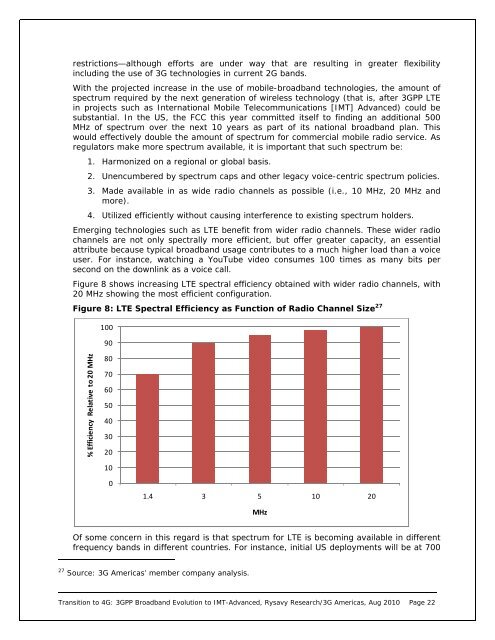estrictions—although efforts are under way that are resulting in greater flexibilityincluding the use of 3G technologies in current 2G bands.With the projected increase in the use of mobile-broadband technologies, the amount ofspectrum required by the next generation of wireless technology (that is, after <strong>3GPP</strong> LTEin projects such as International Mobile Telecommunications [<strong>IMT</strong>] <strong>Advanced</strong>) could besubstantial. In the US, the FCC this year committed itself <strong>to</strong> finding an additional 500MHz of spectrum over the next 10 years as part of its national broadband plan. Thiswould effectively double the amount of spectrum for commercial mobile radio service. Asregula<strong>to</strong>rs make more spectrum available, it is important that such spectrum be:1. Harmonized on a regional or global basis.2. Unencumbered by spectrum caps and other legacy voice-centric spectrum policies.3. Made available in as wide radio channels as possible (i.e., 10 MHz, 20 MHz andmore).4. Utilized efficiently without causing interference <strong>to</strong> existing spectrum holders.Emerging technologies such as LTE benefit from wider radio channels. These wider radiochannels are not only spectrally more efficient, but offer greater capacity, an essentialattribute because typical broadband usage contributes <strong>to</strong> a much higher load than a voiceuser. For instance, watching a YouTube video consumes 100 times as many bits persecond on the downlink as a voice call.Figure 8 shows increasing LTE spectral efficiency obtained with wider radio channels, with20 MHz showing the most efficient configuration.Figure 8: LTE Spectral Efficiency as Function of Radio Channel Size 2710090% Efficiency Relative <strong>to</strong> 20 MHz807060504030201001.4 3 5 10 20MHzOf some concern in this regard is that spectrum for LTE is becoming available in differentfrequency bands in different countries. For instance, initial US deployments will be at 70027 Source: 3G <strong>Americas</strong>’ member company analysis.Transition <strong>to</strong> <strong>4G</strong>: <strong>3GPP</strong> <strong>Broadband</strong> <strong>Evolution</strong> <strong>to</strong> <strong>IMT</strong>-<strong>Advanced</strong>, Rysavy Research/3G <strong>Americas</strong>, Aug 2010 Page 22
MHz, in Japan at 1500 MHz and in Europe at 2.6 GHz. Thus, with so many varyingspectrum bands, it will most likely necessitate that roaming operation be based on GSMor HSPA on common regional or global bands.Core-Network <strong>Evolution</strong><strong>3GPP</strong> is defining a series of enhancements <strong>to</strong> the core network <strong>to</strong> improve networkperformance and the range of services provided, and <strong>to</strong> enable a shift <strong>to</strong> all-IParchitectures.One way <strong>to</strong> improve core-network performance is by using flatter architectures. The morehierarchical a network, the more easily it can be managed centrally; the tradeoff,however, is reduced performance, especially for data communications, because packetsmust traverse and be processed by multiple nodes in the network. To improve dataperformance and, in particular, <strong>to</strong> reduce latency (delays), <strong>3GPP</strong> has defined a number ofenhancements in Release 7 and Release 8 that reduce the number of processing nodesand result in a flatter architecture.In Release 7, an option called one-tunnel architecture allows opera<strong>to</strong>rs <strong>to</strong> configure theirnetworks so that user data bypasses a serving node and travels directly via a gatewaynode. There is also an option <strong>to</strong> integrate the functionality of the radio-network controllerdirectly in<strong>to</strong> the base station.For Release 8, <strong>3GPP</strong> has defined an entirely new core network, called the EPC, previouslyreferred <strong>to</strong> as SAE. The key features and capabilities of EPC include:Reduced latency and higher data performance through a flatter architecture.Support for both LTE radio-access networks and interworking with GSM-HSPAradio-access networks.The ability <strong>to</strong> integrate non-<strong>3GPP</strong> networks such as WiMAX.Optimization for all services provided via IP.Sophisticated, network-controlled, quality-of-service architecture.This paper provides further details in the sections on HSPA <strong>Evolution</strong> (HSPA+) and EPC.Service <strong>Evolution</strong>Not only do <strong>3GPP</strong> technologies provide continual improvements in capacity and dataperformance, they also evolve capabilities that expand the services available <strong>to</strong>subscribers. Key service advances include Fixed Mobile Convergence (FMC), IMS, andbroadcasting technologies. This section provides an overview of these <strong>to</strong>pics, and theappendix provides greater detail on each of these items.FMC refers <strong>to</strong> the integration of fixed services (such as telephony provided by wireline orWi-Fi) with mobile cellular-based services. Though FMC is still in its early stages ofdeployment by opera<strong>to</strong>rs, it promises <strong>to</strong> provide significant benefits <strong>to</strong> both users andopera<strong>to</strong>rs. For users, FMC will simplify how they communicate making it possible for them<strong>to</strong> use one device (for example, a cell phone) at work and at home where it mightconnect via a Wi-Fi network or a fem<strong>to</strong>cell. When mobile, users connect via a cellularnetwork. Users will also benefit from single voice mailboxes and single phone numbers,as well as the ability <strong>to</strong> control how and with whom they communicate. For opera<strong>to</strong>rs,FMC allows the consolidation of core services across multiple-access networks. Forinstance, an opera<strong>to</strong>r could offer complete VoIP-based voice service that supports accessTransition <strong>to</strong> <strong>4G</strong>: <strong>3GPP</strong> <strong>Broadband</strong> <strong>Evolution</strong> <strong>to</strong> <strong>IMT</strong>-<strong>Advanced</strong>, Rysavy Research/3G <strong>Americas</strong>, Aug 2010 Page 23
















